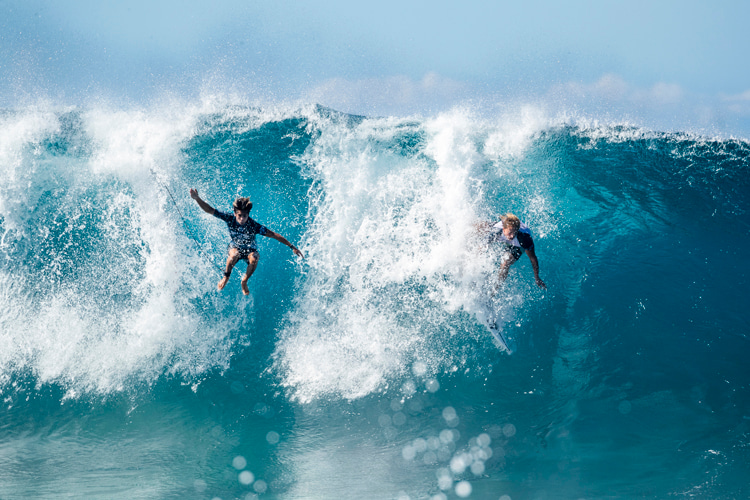We were sitting by the buoy one day early in March, arrogantly surveying the scene.
I had not yet recovered from the interruption of my surfing activities during part of February, and so I was enjoying the interval between rides.
The waves that day were quite spasmodic, although when they did come, they were three or four feet tall and were crashing over rather heavily with a continuous line of convex, glass-like water.
The foam was correspondingly lumpy and was occasionally hard to negotiate so after we got up, we had to stand with our feet wider apart in order to make the ride more stable.
The waves at Waikiki, or anywhere else for that matter, come in sets of several at a time.
Many people say that there are nine to a set and that the seventh is the largest, but anyone who has made even a cursory study of this unlikely fact will tell you it is not true.
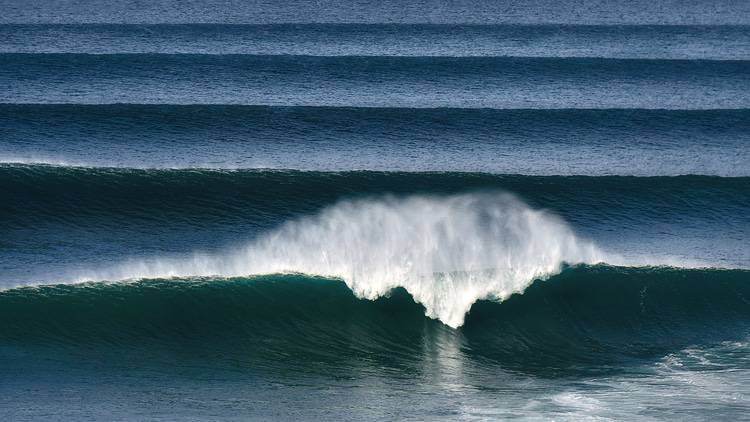
The False Sense of Security
We had been waiting for about ten minutes, lulled into that false sense of security that an apparently calm sea induces, and with that slightly unreal feeling that sitting on a stationary surfboard seems to encourage when I saw a good set approaching.
The swells start to appear further out to sea, well beyond the buoy and gradually shape up as they near you, although in the winter months, quite often the waves begin as long narrow blisters on the water's surface, with a broad central peak, and attenuated sloping ends or shoulders.
This wave type has its genesis between the buoy and the beach, as a rule.
Now and then, the waves come in long lines that start so far out they are still visible in the distance.
Sometimes, it is worth paddling out to meet these to get a longer ride. Sometimes, a wave will break further out than usual, disturbing the natural rhythm of the cycle.
As they approached the buoy, the waves increased in size and gathered strength for the imminent break; gradually, the peaks were forced upward by the shallowing waters, and long dark shadows were cast across their silver ridges.
The first two or three waves of the set were not particularly large, and I coolly let the surfboard rise over them while taking another look toward the horizon.
It was no longer there.
In stark disbelief, I brushed my hand across my eyes and looked again at the rampant monster that was blotting out the sky.
Streaming toward us like a fast-moving blue cliff was what I was convinced must be the world's largest wave, exhibiting the power of an extravagance to make one's flesh creep and ferociously curling and frothing at the tip.
"Help!" I thought desperately - a tidal wave.
It reminded me of that popular Japanese print known as "The Great Wave" of Hokusai.
As the wave drew closer, stretching it seemed across the entire bay and reaching up into the sky, the early morning surfing fraternity of Waikiki Beach dispersed like the leaves of an autumn day.
Larry was among the last to depart.
He had been a bit further out, and with commendable presence of mind, he paddled straight for the wave to try to make it to the outside; with his board almost vertical, he just managed to teeter over the top.
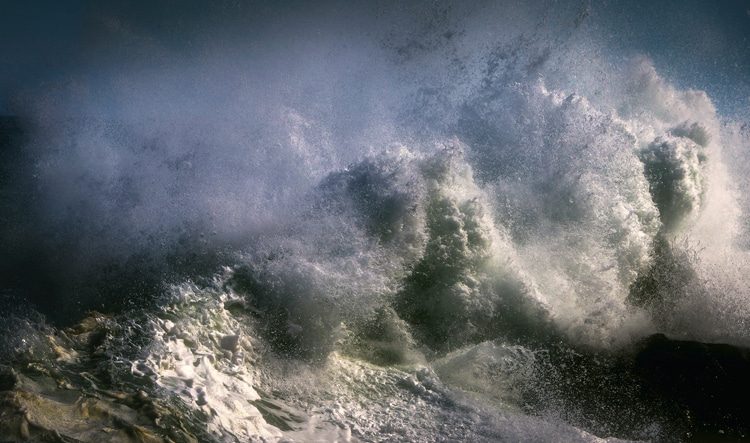
Taming a Beast
I was suddenly all alone, and believe me, it was a terrible feeling.
I felt like a beginning lion tamer trapped by accident in a cage with a vicious, untamed lion.
The myriad emotions of the man in the tight spot coursed through me, specializing in those two more normal reactions: chronic indecision and blind panic.
What to do? Try and sit it out?
I remembered vaguely something about pulling the board up to 45 degrees with arms out straight and legs around it.
A quick look back convinced me of the unpromising nature of this solution. Dive to clear the board?
Memories of pictures I had seen of stalwarts doing this at Sunset and Makaha, with huge waves going crunch behind them, stirred me to satisfying thoughts of bravery, but the prospects of the long swim to the shore soon squelched that.
I could paddle with huge strokes for the beach, hoping to outrun the break and prone out in the soup.
But that would take enormous energy, and I suppose at 7:15 a.m. I simply didn't feel like it.
I could, of course, do nothing, but he who hesitates is lost, as I had often been told at school. So I did the worst thing possible.
I took a few very feeble strokes shoreward, while out of the corner of my eye, I could see that I was in the trough, and the inevitable was towering above me like the side of a two-story house.
Suddenly, I felt myself rising as if a giant hand had grasped the board, and together with the board, I shot up to the top of the wave backward, higher, higher, up, up, up, until for a brief but wonderful second, I thought it was going to pass over such a chicken-hearted type in sheer scorn.
For a ghastly moment, I hung suspended in space, a lone, pathetic figure with my arms wrapped hopelessly around my beloved board on top of this towering mountain of moving water.
Oh, if I were only spared this time, I would not venture so far out again for months, etc.
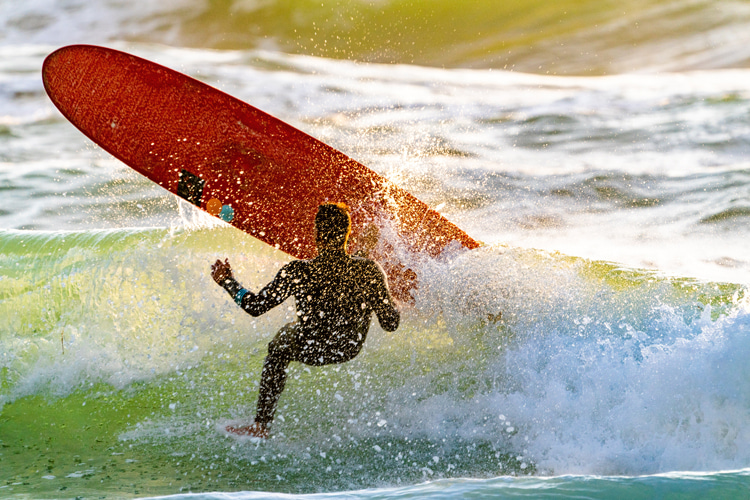
Going Down
And then the dreadful descent began.
The board, with myself miraculously still in tenancy, shot down the wave at what appeared to be at least ninety miles an hour and exploded into the trough in a series of long, shuddering jolts, during which the tip kept rearing up and thumping down on the water again with a sickening percussion.
To my amazement, I found myself still in one piece, although somewhat shaken and with the board still right-way-up on the surface of the water, we having together unwittingly taken the drop on a large wave.
The board had slowed considerably indeed; it was by now barely moving, having for a moment out-distanced the momentum of the wave.
Wallowing further in fear and indecision and unhappily noting that the wave was still behind me, with shades of Gilbert's forthright instruction ringing in my ears, I did the second-worst thing possible.
I stood up.
At that moment, we must have reached the shelf where the reef starts to flatten out, or perhaps the wave's height became one-seventh the distance between the crests because just as I was safely on my feet (a miserable object astride an almost stationary board) with a thunderous roar, an enormous hiss and a horrible guggling noise like a giant laughing, the Universe collapsed on me.
Robert Louis Stevenson's father is said to be the first man to measure the force unleashed by a breaking wave.
With an instrument he had personally constructed, he estimated this force to be as much as 6,000 pounds per square inch.
This was later shown to be an underestimate.
Figuring my personal surface area, which was exposed to the wave at 1,316 square inches, indicates that I was momentarily subjected to 7,896,000 pounds or about 4,000 tons of water pressure from that bursting wave.
Of course, I don't believe it was that much anymore, but at the time it happened, you could have convinced me easily.
My board was the first to leave the scene, as if in disgust at its owner's performance, taking off like a tarpon for the upper air - 10 or 15 feet up, they told me afterward.
It had first shot down into the water, sliding me off on my journey into the abyss in what we lamely call pearl diving but the Australians more graphically call going down the mineshaft.
For some reason, I missed the bottom as I revolved in the tremendous suction of the undertow, curled up like a fetus in a womb.
Convinced my world had come to an end, I watched like a spectator in an aquarium as ten thousand bubbles orbited my head, and I continued to roll over endlessly in the whirlwind turbulence of the soup.
If this was the end of the world, I thought, it was at least a white world inhabited only by foam and bubbles.
With this modest return of my thinking process, I was fortunately galvanized into action.
Suddenly, I began to lunge again, frog-like, with my arms and legs, and after what must have been only a few seconds, but what seemed like an eternity, I broke through the surface and took the most welcome gulp of invigorating fresh air that I can recall taking up to that moment.
If I thought that my trials were over, I was in for disillusionment. My first reaction after taking air was one of unbridled relief.
This was closely pursued by the second reaction, which was one of abnormal insecurity and panic since, in spite of my frenzied efforts to stay up, I seemed to have lost my normal buoyancy.
There was an awful sucking feeling, and the sea seemed determined to get me. It took me some while to figure out the reason.
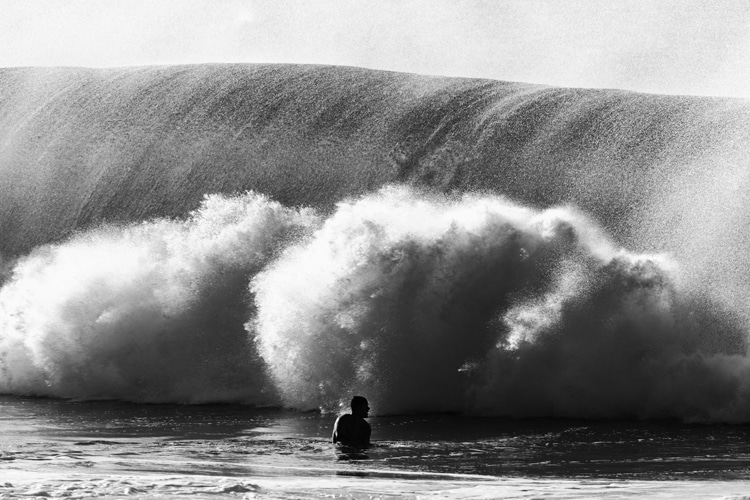
Gasping for Air
The foam which results from a breaking wave is, as we have already seen, composed mainly of air bubbles, and obviously, these have only a small percentage of the upthrust of unbroken sea water.
So unless you have the gift of flight, you have to struggle to stay afloat until the foam has subsided and there is dense water beneath you again.
My panic at this time was accentuated by the loss of my board, which was disappearing over the horizon on the heaviest crest of the broken wave.
With my pin-sized head bobbing in the desolate white water, suddenly, I realized that the Pacific stretches to Australia.
In seconds, I decreased even further in size, and the ocean became enormous.
At this crucial point, another (fortunately small) wave broke on top of me.
This was the last straw, and I probably took a gulp of seawater as, with fractured spirit, I came to the top again, letting out a piteous wail.
After the second wave broke over me, I knew I could not swim for it. The desire was not there, neither was the moral fiber, whatever that is.
I suddenly discovered what a completely brainwashed man must feel like.
Making a half-hearted attempt to tread water, I looked around hopelessly.
Through a haze of spray, I saw George, who appeared out of the mist some fifty yards away, so I beckoned feebly.
He came swiftly over, and I clasped his board with a croak that had started out as a sigh of relief.
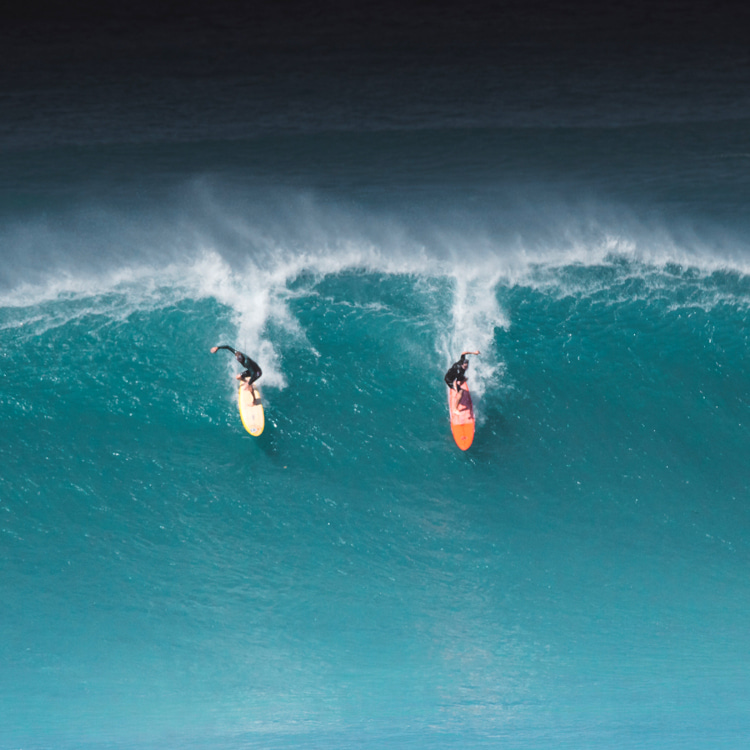
Learning From Failure
I spent the rest of that day on dry land. Your first wipeout is your most spectacular and your most memorable.
I have since had more wipeouts, but they are a blur on the pneuma of my consciousness.
But that first one is psychologically indelible.
In the comparative safety of the Banyan Terrace, we reflected on what I had done wrong that day. The answer was simple - everything.
The first rule, if such exists, is not to panic.
Admittedly, this is easier said than done, but the "cool head, Brudda" of the Hawaiian surfers is sooner or later essential if you are to stay alive.
Panic merely makes you physically and mentally ineffectual, and this state is accentuated if you are bounced about in the soup or undertow.
The fact that I shot up to the top of the wave means that it was still not so steep that I couldn't have cut out from it had I been an experienced surfer.
Larry had been correct in attempting to paddle outside since he felt he could make it.
As you become more experienced, a sixth sense seems to tell you where the waves will break, although sooner or later, you are bound to be caught by a big one unloading in the wrong place, and you'll try and make it outside, but you won't.
Wipeouts are inevitable, but most bad ones can be avoided by good judgment.
If caught in the same situation today, I would have pointed the board toward the shore, sat right back toward the stern, and clamped my legs around the board in a vice-like grip, meanwhile clasping the sides firmly with my arms outstretched.
The nose of the board is then high in the air.
This position will get you safely over any wave that doesn't actually break on you, but of course, the exact breaking point is hard to gauge.
All I can say is that it is surprisingly effective, and if you are unsure at all, practice in many types of waves until you know what to expect.
The alternative would have been to vacate the board, dive under the wave, and stay as near as possible to the bottom until the turbulence had passed.
This takes quite a lot of courage for the beginner and will be treated in more detail in a subsequent chapter.
Physical and Mental Training
It also assumes a swimming ability and state of training or conditioning, which many people don't have, yet which, with very few exceptions, is completely essential in surfing of any size over three feet.
It is not enough to be able to swim half a mile in a private pool.
After a wipeout, most people have taken a pretty bad buffeting both physically and mentally, and the thought of a long swim takes quite a bit of adjusting to.
If you are caught in a bad wipeout, there are several methods of gaining time to restore your equilibrium.
The best consists of flopping your head in the water with the arms forward and floating face down, and taking occasional breaths as you need them.
After a while, you can stay afloat for hours this way.
At Waikiki, in most places, you can also bounce up and down off the bottom, taking a breath as you come up. The deepest water over the reef is seldom over ten feet.
The important thing here is not to be afraid of frequently getting your head underwater.
The best stroke with which to pursue your board is the breast-stroke, as it expends the least energy, and you can then keep a lookout around you more easily.
The second-best stroke is the side-stroke, which many people use, and the worst is the crawl, which gives you the least control in rough water.
You can bodysurf in on the ensuing breakers if you are a strong enough swimmer.
However, if you are not, remember that sea water is extremely buoyant, and even a non-swimmer can stay afloat indefinitely if he doesn't panic; and if he stays in the line-up, he will sooner or later get washed ashore.
As the surf came up, I suffered several other wipeouts which shook me up, and several times I was either lucky enough to be able to stand, or I seized hold of Larry's or somebody else's board to avoid a swim (including one bikini-clad young lady who gave me a look of withering scorn I have not forgotten).
This attitude toward swimming is, of course, ridiculous and is asking for trouble. You should not surf in any area where you are likely to need help if wiped out.
The payoff came one day at Waikiki when I was attempting to teach a friend from the mainland.
I was pushing him toward the shore when I let my own board loose.
The northeast trades quickly caught the board, and as I looked around, it was vanishing out to sea at a steady clip.
I immediately set out after it with no help whatsoever from the trades and only just caught it about four or five hundred yards further out.
Needless to say, the effort exhausted me so much that at several points, I felt neither the ability to catch the board nor the energy to return back to the shore, and from then on, I used to practice swimming to the buoy and back, a total distance of some 1,000 yards, once a week until my confidence increased.
For a long time after this, I would not go out in the heavier surf again.
When I eventually did go back, each time out, I would carefully assess the chances of a wipeout, and as George Downing suggested, I would avoid them whenever possible. He does.
No one who surfs, however, can avoid them completely, for wipeouts are an integral part of the compounded risks and thrills of surfing.
And later, as the vision of past surfing experiences on many different beaches and in many different countries tracks like a movie reel on your surfer's memory, suddenly you will find that even a bad wipeout has a strange, fearful beauty as the great wave comes down in its magnificent, carved arcade of dazzling whiteness, and you are once more consigned to the mysterious depths of the blue Pacific.
Words by Desmond Muirhead | Golf Course Designer and Author of the Book "Surfing in Hawaii" (1962)
Chapter VI of "Surfing in Hawaii" was published under the authorization of Rosemary J. Muirhead, one of the three daughters of Desmond Muirhead
